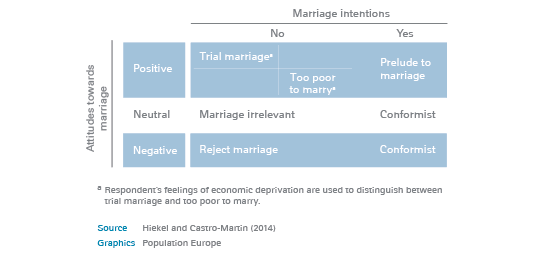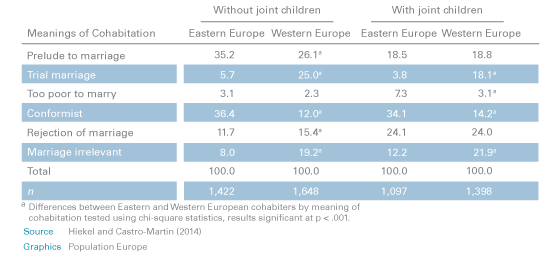Traditional family patterns are losing popularity in Europe. One example of this is the fact that more and more people are living together without getting married. Cohabitation means different things to different people, and people choose this family arrangement for various reasons. Do these reasons influence their fertility intentions? In a recent study, Nicole Hiekel and Teresa Castro-Martin examine how the different meanings of cohabitation and the intention to have a child are intertwined.
Using data from the Generations and Gender Surveys on 5,565 cohabiters from 9 European countries (Austria, Bulgaria, France, Germany, Hungary, Lithuania, Norway, Romania, and Russia), the authors propose a cohabitation typology (figure 1) based on whether individuals consider marriage an outdated institution, their plans to marry in the near future, and whether they have troubles making ends meet. Based on these factors, they examine the linkages between the meaning of cohabitation and short-term fertility intentions, taking into consideration potential differences between cohabiters with and without joint children and potential divergences between Eastern and Western Europe.

Figure 1: Typology of cohabitation
Their findings suggest that across Europe, cohabiters’ intentions to have a child are still closely associated with plans to get married. This result indicates that marriages are not necessarily becoming irrelevant in the process of family formation. And, the result supports prior research, showing that the anticipation of marriage increases cohabiters’ willingness to make relationship-specific investments to further strengthen the commitment between the partners, such as planning for and having children. In addition, cohabiters who perceived their union as having a long-term perspective, who did not feel too low-income to marry, who valued the institution of marriage, and in particular those who planned to marry in the near future were more prone to intend to have a child than the other types of couples.
Regarding regional differences, cohabitation differs a lot between East and West Europe in terms of timing and prevalence in the life course (table 1). The proportion of cohabiters who see their union as a stage in the marriage process or who plan to marry despite holding unfavorable attitudes toward the institution of marriage is higher in Eastern Europe than in Western Europe. In turn, viewing cohabitation as an alternative to marriage and as a trial marriage is less widespread in this region. However, and surprisingly, the authors found that the ways in which the meanings of cohabitation are associated with plans to have a child actually do not differ across Europe.

Table 1: Percentage distribution of cohabiters without (n=3,070) and with joint children (n= 2,495) in Eastern and Western Europe by meanings of cohabitation
Finally, it was found that cohabiters with children were overrepresented among those who viewed their union as an alternative to marriage (i.e., reject the idea of marriage or find it to be irrelevant) and those who were too low-income to marry. The intention to marry was less important for fertility intentions among cohabiters with children than among those without.
This PopDigest is also available in French, Spanish and German.

*This PopDigest has received funding from the European Union's Seventh Framework Programme (FP7/2007-2013) under grant agreement n° 320116 for the research project FamiliesAndSocieties.
FamiliesAndSocieties (www.familiesandsocieties.eu) has the aim to investigate the diversity of family forms, relationships and life courses in Europe, to assess the compatibility of existing policies with these changes, and to contribute to evidence-based policy-making. The consortium brings together 25 leading universities and research institutes in 15 European countries and three transnational civil society organizations.